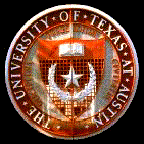
Department of Astronomy
The University of Texas at Austin
1 University Station C1400, RLM 16.224y
Austin, TX 78712-0259
Email: sj@astro.as.utexas.edu
Phone: (512) 471 1395
Fax : (512) 471 6016
URL : http://www.as.utexas.edu/~sj

|
Dr. Shardha Jogee Department of Astronomy The University of Texas at Austin 1 University Station C1400, RLM 16.224y Austin, TX 78712-0259 Email: sj@astro.as.utexas.edu Phone: (512) 471 1395 Fax : (512) 471 6016 URL : http://www.as.utexas.edu/~sj |
|
|
Education
|
I am a Professor in the Astronomy Department at the University of Texas at Austin |
|
CV |
|
|
Awards |
|
|
Research |
|
|
Publications |
|
|
Press Coverage |
|
|
Classes |
- NASA Long Term Space Astrophysics (LTSA) grant ($558,000), Mar 2003 (PI).
` Structure and dynamics of local and intermediate redshift disks'
- American Association of University Women Educational Fellowship (AAUWEF), 1996
- Amelia Earheart Fellowship, Zonta International, 1996
- Yale University J. F. Enders Research Grant, Yale University, 1995
- Sigma Xi Grants-in-Aid of Research, Sigma Xi Society, 1995
- Yale University J. F. Enders Fellowship, Yale University, 1995
- Garfinkel Prize, Yale University, 1992
- Elected to status of Fellow, Cambridge University, England, 1990-1992
- Undergraduate Academic Scholarship in Physics, Cambridge University, England, 1989-1992
Research Interests
- Galaxy Formation and Evolution
- Structure and Dynamics of Galaxies from z=0 to 3, in particular : (1) Bar-Driven Evolution of Disk Galaxies ; (2) Strength and impact of tidal interactions/mergers on star formation, mass assembly history, and galaxy evolution.
- Evolution and Fueling of Central Starbursts and Black Holes (AGN)
- Interstellar Medium and Molecular Gas in Galaxies.
Research Group/Advisees
- Mar 2004--Present : Dr. Fabio Barazza, Postdoctoral Fellow, STScI
- Jan 2004--Present : Dr. Ingo Berentzen, Postdoctoral Fellow (co-supervised with Prof. Isaac Shlosman at the University of Kentucky)
- Nov 2002--Present: STScI Masters Level researchers: James Davies Inge Heyer
- June 2003--2004: Gabriel Lubell, summer student, Vassar College/STScI
- Sep 2002--03: Naveen Reddy, graduate student, CalTech (co-supervised with Prof. Nick Scoville)
Research Projects
My current research program addreses observational and theoretical aspects of the evolution, structure and activities of disk galaxies over a wide range of cosmic lookback times, from the present-day out to intermediate redshifts when the Universe was less than half of its present age. The projects involves the analysis of space-based ( HST, Chandra, SIRTF ) and ground-based optical, NIR, and radio data, as well as a concurrent collaborative development of the theoretical framework addressing disk evolution:
- As a team member of the Great Observatories Origins Deep Survey (GOODS) and Galaxy Evolution from Morphology and SEDs (GEMS) , which are the two largest panchromatic surveys completed to date with the HST Advanced Camera for Surveys, I am investigating:
Tidal Interactions and Mergers at Early Cosmic Times (pdf): We study the frequency and impact of tidal interactions and mergers out to z~1, when the Universe was half of its present age, in order to build a coherent picture of the decline in cosmic SFR density from z~1 to 0 and the mass assembly of galaxies.
Bar-Driven Galaxy Evolution in the Young Universe (pdf): Non-axisymmetric features such as bars drive the dynamical and secular evolution of disk galaxies by exerting gravitational torques which redistribute mass and angular momentum. While most (> 70 %) spirals are barred in the local Universe, early studies of the Hubble Deep Field (HDF) suggest a remarkably low bar fraction (< 20 %) at intermediate redshifts (z=0.5-0.8). If confirmed, this result would imply that disks at these epochs are fundamentally different from present-day spirals. Using GOODS and GEMS data, we revisit the recoverability, fraction, and properties of bars out to redshift ~1 . We discuss the implications for the formation, structure and activities of disk galaxies. We also present first results to analyze the stability of bars embedded in massive halos of various central concentrations and asymmetries.
- Member of the STScI Home Team for planning the HST/ACS Ultra Deep Field (UDF) which is expected to reach up to 1.5 mag deeper than the Hubble Deep Field (HDF) and provide the deepest optical view of the Universe.
- Astrotheme (in German) Science Orf (in German)
- Le Mauricien (in French)
WWW home page (last update Nov. 1, 2003)